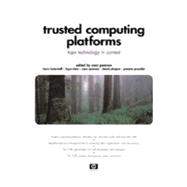
Note: Supplemental materials are not guaranteed with Rental or Used book purchases.
Purchase Benefits
About the Editor
DR. SIANI PEARSON is a Research Scientist at Hewlett Packard's Trusted e-Services Lab and has been a key member of the HP Labs team involved in founding and developing the Trusted Computer Platform Alliance (TCPA). She holds a Ph.D. in automated theorem proving at Edinburgh University and earned a fellowship at Cambridge University working in the same field. For the past four years, her research has focused on computer security, trust, and privacy.
With contributions from:
(NOTE: Each chapter concludes with Summary.)
Preface.
Acknowledgments.
Disclaimer.
About the Authors.
I. INTRODUCING TRUSTED PLATFORM TECHNOLOGY.
1. Trusted (Computing) Platforms: An Overview.II. TRUST MECHANISMS IN A TRUSTED PLATFORM.
III. TRUSTED PLATFORMS IN PRACTICE.
IV. TRUSTED PLATFORMS FOR ORGANIZATIONS AND INDIVIDUALS.
The New copy of this book will include any supplemental materials advertised. Please check the title of the book to determine if it should include any access cards, study guides, lab manuals, CDs, etc.
The Used, Rental and eBook copies of this book are not guaranteed to include any supplemental materials. Typically, only the book itself is included. This is true even if the title states it includes any access cards, study guides, lab manuals, CDs, etc.